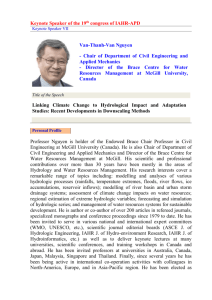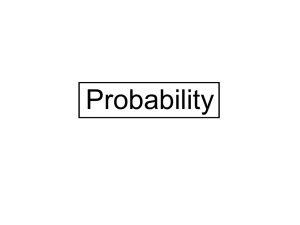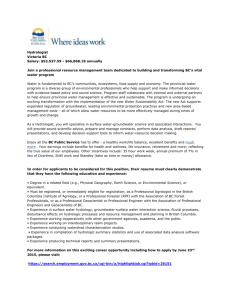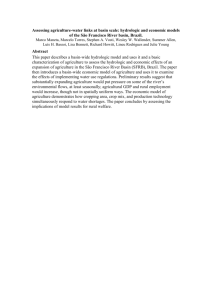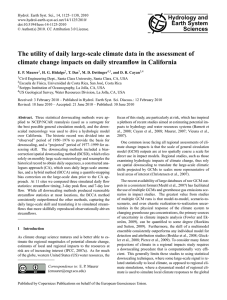Responding to Evolving Stakeholder Needs for 21 Century Hydrologic Scenarios:
advertisement
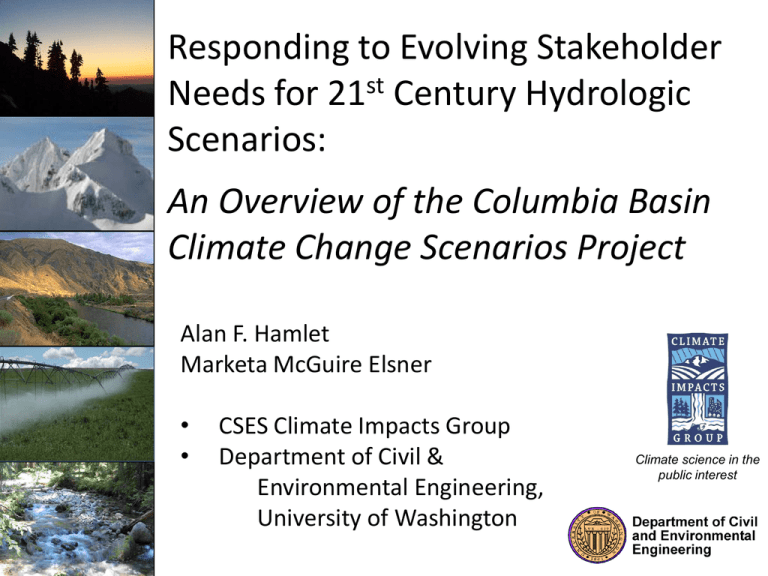
Responding to Evolving Stakeholder Needs for 21st Century Hydrologic Scenarios: An Overview of the Columbia Basin Climate Change Scenarios Project Alan F. Hamlet Marketa McGuire Elsner • • CSES Climate Impacts Group Department of Civil & Environmental Engineering, University of Washington Climate science in the public interest Climate Change Planning Needs are Evolving Stakeholder requests: 1. Address diverse stakeholder planning needs (terrestrial and aquatic ecosystems, water management, human health, energy, etc.) 2. Provide comprehensive coverage over large geographic areas using consistent methods 3. Increase spatial resolution -- address both large-scale and small-scale planning efforts in a consistent manner 4. Increase temporal resolution -- address changes at daily timescales and assess changes in hydrologic extremes 5. Quantify uncertainties in future projections The Columbia Basin Climate Change Scenarios Project This 2-year research project (finalizing Spring 2010) is designed to provide a comprehensive suite of 21st century hydroclimatological scenarios for the Columbia River basin and coastal drainages in OR and WA. Collaborative Partners: • • • • • WA State Dept. of Ecology (via HB 2860) Bonneville Power Administration Northwest Power and Conservation Council Oregon Water Resources Department BC Ministry of the Environment Project Goals and Objectives • Provide a wide range of products to address multiple stakeholder needs • Increase spatial and temporal resolution • Provide a large ensemble of climate scenarios to assess uncertainties • Address hydrologic extremes (e.g. Q100 and 7Q10) 297 Streamflow Sites http://www.hydro.washington.edu/2860/ Overview of Methods Primary Meteorological Stations Used to Create Spatial Dataset* (1915-2006) *1/16 spatial resolution & daily timestep Climate Change Scenarios IPCC AR 4 Emissions Scenarios: A1B Medium High B1 Low Figure shows change compared with 1970 1999 average Climate Impacts Group 2009, WA Assessment, Ch. 1 http://cses.washington.edu/cig/res/ia/waccia.shtml Downscaling Relates the “Large” to the “Small” ~200 km (~125 mi) resolution ~5 km (~3 mi) resolution Statistical Downscaling Approaches Composite Delta Method Strengths: • Simple, easy to explain “snapshot” of average future conditions • Incorporates realistic historical daily time series and spatial variability • Provides 91 years of historical variability combined with changes in T and P for each future time frame and emissions scenario • Projections are easily relate to stakeholder knowledge of historical impacts Limitations: • Incorporates only average changes in mean monthly T and P, not extremes • Changes are assumed to be the same throughout the region Statistical Downscaling Approaches Bias Corrected and Spatially Downscaled (BCSD) Strengths: • Incorporates more information from the monthly GCMs, including altered monthly T and P variability in space and time • Produces a transient (i.e. continually varying) daily time series for 150 years (1950-2098+) • Simulates rates of change in hydrologic variables • Offers flexible time period of analysis (one run gives all future time periods) Limitations: • Quality of downscaled realizations is dependent on GCM performance – What you get out is only as good as what you put in! • Ensemble analysis needed to account for decadal P variability due to relatively small sample size in future time slices (~30 years) • Daily time series characteristics are not suitable for some kinds of analyses (e.g. analysis of hydrologic extremes) Statistical Downscaling Approaches Hybrid Delta Method Strengths: • Combines the strengths of the Composite Delta and BCSD methods, while avoiding most of the weaknesses of both • Incorporates more information from the monthly GCMs, including altered spatial patterns of T and P changes • Incorporates realistic historical daily time series and spatial variability • Provides 91 years of historical variability combined with changes in T and P for each future time frame and emissions scenario • Arguably the best method for evaluating hydrologic extremes (floods and low flows) Limitations: • Quality of downscaled realizations is dependent on GCM performance (spatial patterns only) • Constrained by the time series behavior in the historic record Available PNW Scenarios Downscaling Approach Hybrid Delta Transient BCSD Delta Method hadcm cnrm_cm ccsm3 echam5 echo_g cgcm3.1_t47 pcm1 miroc_3.2 ipsl_cm4 hadgem1 hadcm cnrm_cm ccsm3 echam5 echo_g cgcm3.1_t47 pcm1 composite of 10 B1 A1B Emissions Emissions Scenario Scenario 2020s 10 10 2040s 10 10 2080s 10 10 1950-2098+ 7 7 2020s 2040s 2080s 1 1 1 1 1 1 2020s – mean 2010-2039; 2040s – mean 2030-2059; 2080s – mean 2070-2099 Schematic of VIC Hydrologic Model • • • General Model Schematic Sophisticated, fully distributed, physically based hydrologic model Widely used globally in climate change applications 1/16 Degree Resolution (~5km x 6km or ~ 3mi x 4mi) Snow Model Sample Results Using Different Statistical Downscaling Approaches Hydrologic Products http://www.hydro.washington.edu/2860/ Changing Watershed Classifications: Transformation From Snow to Rain * Based on Composite Delta Method scenarios (multimodel average change in T & P) Map: Rob Norheim Trends in Date of Peak SWE Linear trend for the ECHAM 5 A1B Scenario downscaled using the transient BCSD Downscaling Method Trend (Days per Decade) * 50mm SWE Plotting Threshold http://www.hydro.washington.edu/2860/products/sites/?site=6092 Snow and Runoff Summary (Cispus River near Randle) Scenario Ensembles Ensemble Mean Historical Mean Who’s Using the Data? Draft study results (to be finalized Spring 2010) are already being used and evaluated by a wide range of stakeholders including: •USGS •Bonneville Power Administration •U.S. Bureau of Reclamation •U.S. Army Corps of Engineers •U.S. Forest Service •U.S. Fish and Wildlife Service •Boise Aquatic Research Laboratory •National Marine Fisheries Science Center Next steps… Extending the approach to additional western US watersheds in partnership with: •US Forest Service •US Fish and Wildlife Service •Boise Aquatic Sciences Lab •Trout Unlimited

